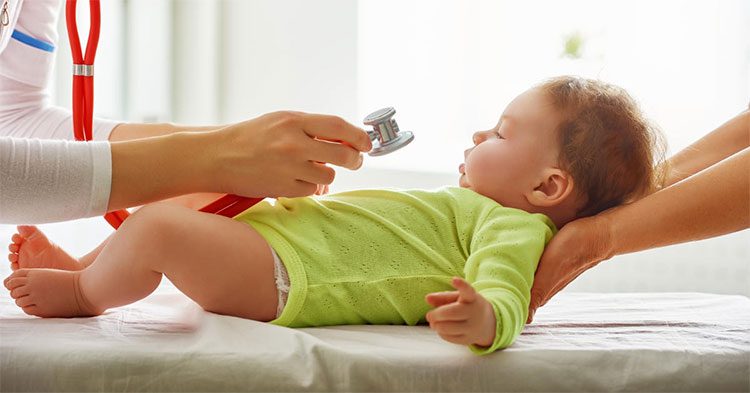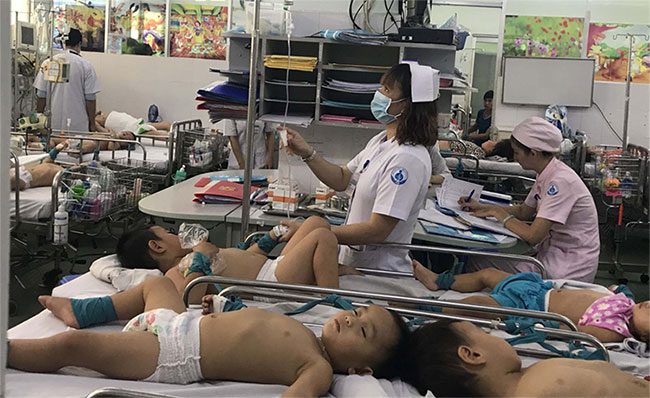Diarrhea, food poisoning, myocardial infarction, and stroke are common illnesses that can occur during the prolonged heat waves we are currently experiencing.
Common Illnesses in Hot Weather
Digestive Disorders
Food poisoning and acute diarrhea are likely to occur when temperatures persist between 37-38 degrees Celsius. Under these conditions, mold and bacteria thrive, causing food to spoil quickly and become foul-smelling. If precautions are not taken, food poisoning and diarrhea can result. Additionally, in hot weather, people tend to drink various beverages to quench their thirst, which increases the risk of consuming contaminated drinks from unknown sources.
Poor appetite and digestive disorders: In excessively hot weather, the digestive system operates less effectively, resulting in decreased secretion of digestive juices and poor absorption, leading to a lack of appetite and unease while eating. Individuals may also experience bloating, indigestion, and loose stools.

Digestive and respiratory disorders are common in children during prolonged hot weather. (Illustrative image).
Cardiovascular Disorders
Patients with a history of cardiovascular issues may experience worsening conditions or may not respond to standard treatments. Common conditions include hypertension, myocardial infarction, angina, and cerebrovascular accidents.
In older adults, sudden temperature changes from hot to cold (such as abruptly entering an air-conditioned room from the heat) can cause blood vessels to constrict suddenly, leading to cerebral ischemia or triggering a myocardial infarction.
Excessive heat can also lead to sweating, resulting in dehydration. Without adequate fluid intake to replenish lost fluids, blood can become more viscous, increasing the burden on the heart and disrupting smooth blood flow. This condition can lead to stagnation of blood vessels and blood clots, causing various complications.
Respiratory Disorders
Common ailments include rhinitis, sinusitis, acute bronchitis, and pneumonia. Patients with a history of chronic bronchitis or asthma are more susceptible to acute episodes due to respiratory infections. Hot weather can dry out and damage the mucous membranes of the respiratory tract.
At normal temperatures, the nasal cavity produces mucus that acts as an antibacterial agent to trap and expel bacteria and viruses. However, in dry and hot climates, the body loses moisture, causing the throat and nasal membranes to dry out. Continuous use of air conditioning or fans further exacerbates the dryness, making it easier for bacteria and viruses to penetrate deeper and cause illness.
Central Nervous System Disorders
Excessive heat can lead to heat exhaustion (heat stroke), causing dizziness, sweating, and fainting. Brain damage due to extreme heat can result in the loss of the body’s ability to regulate temperature and multi-organ failure, which can be fatal. Symptoms include high fever (41-42 degrees Celsius) that does not respond to antipyretics, seizures, delirium, and potentially coma, along with slow or irregular heartbeats and low blood pressure.
Heat can be especially dangerous for infants whose cardiovascular, respiratory, and brain systems are not fully developed to cope and regulate temperature according to environmental conditions. Young children also lack the awareness to drink sufficient water and maintain hygiene. Additionally, individuals over 60 years old are at higher risk for heat-related illnesses due to decreased immunity and aging organs.
Viral Infections
The hot season is also a time when children are more prone to viral infections, leading to symptoms such as fever, rashes, irritability, vomiting, and difficulty eating.
Currently, there are over 200 strains of viruses identified, most of which are common viruses that are relatively harmless to children and can resolve on their own within 5-7 days with proper monitoring and care.
However, some dangerous viruses can harm children, so it is important to take proactive preventive measures with available vaccines such as those for influenza, measles, varicella, mumps, and rubella.
Japanese Encephalitis B, Meningitis in Children
According to infectious disease experts, the incidence of Japanese Encephalitis B in children tends to rise during the hot season compared to the rainy season. This condition can be quite serious if it progresses without timely detection.
Hand, Foot, and Mouth Disease

Children with hand, foot, and mouth disease being treated at Children’s Hospital 1.
This disease is common in children under 5 years old, particularly in those under 3, with a high transmission rate. It is particularly related to personal hygiene and environmental cleanliness.
The disease can be serious if neurological complications arise, such as tremors, seizures, muscle rigidity, panic, or confusion. If parents observe these symptoms, they should promptly take their child to the hospital for timely treatment.
Fever
Weather changes, heavy rainfall, and prolonged high humidity are factors that contribute to the outbreak of viral fevers.
When afflicted with a viral fever, patients may experience common symptoms such as: high fever above 38.5 degrees Celsius; body aches; cough; runny nose; loss of appetite; or swollen lymph nodes in the head, face, and neck.
Typically, viral fevers are easily transmitted from person to person, especially through respiratory and digestive routes. Therefore, individuals with symptoms of a viral fever should minimize contact with others to prevent spreading the infection.
Skin Conditions
Humid weather and high humidity levels create conditions for bacteria to spread and develop, leading to skin disorders.
Most patients primarily suffer from weather allergies, allergic dermatitis, urticaria, skin inflammation, or fungal infections due to insect bites or wearing damp clothing.
To limit skin-related illnesses during hot and humid days, it is recommended to clean and care for the skin daily, and to keep bedding and clothing dry, clean, and fresh.
Dengue Fever
Dengue fever typically persists from the rainy season into the hot season. Early detection is crucial to avoid complications.
Heat Edema
The most typical and common condition is heat edema. This symptom often appears when individuals abruptly change environments, such as traveling to areas with much higher temperatures than usual. Another scenario is moving from an air-conditioned room to a hot outdoor environment.
Heat edema typically manifests as swelling in lower parts of the body, such as the eyelids or feet. According to doctors, this phenomenon occurs because blood vessels dilate to expel heat, causing swelling. These symptoms usually resolve within a few hours or days as the body acclimates to the new environment.
Doctors recommend that if symptoms persist, elevating the legs while sleeping can help improve blood circulation. Generally, no medication is necessary for these symptoms.
Many people, worried and following the advice of others, have taken diuretics to reduce swelling. However, doctors advise that this is not beneficial and can harm the body by exacerbating dehydration.
Other Illnesses
In hot and humid weather, children often suffer from prickly heat that causes itchiness and discomfort, or they may experience heat exhaustion if they play outside in the sun for too long, as their bodies lose significant amounts of water and minerals through sweat and respiration.
Parents need to enhance their awareness of preventive measures during the hot season to protect children’s health, such as establishing good personal hygiene habits: washing hands properly before eating, after using the toilet, and after playing; eating hygienically; creating a clean and safe living environment to limit the spread of dangerous infectious diseases.
Prevention Methods
The best way to prevent heat-related illnesses is to stay hydrated and carry a cool cloth to help the body release excess heat.
It is advisable to consume freshly cooked food and avoid storing too much food as it is harder to preserve. Those with respiratory or cardiovascular conditions should visit their doctor more frequently for advice and medication adjustments.
When using air conditioning, families should set the temperature to 27-28 degrees Celsius. Avoid sudden temperature changes from hot to cold; instead, make gradual adjustments. For example, when coming in from the heat, first wash your face with water or wipe your face with a damp cloth before slowly entering the air-conditioned room.


















































